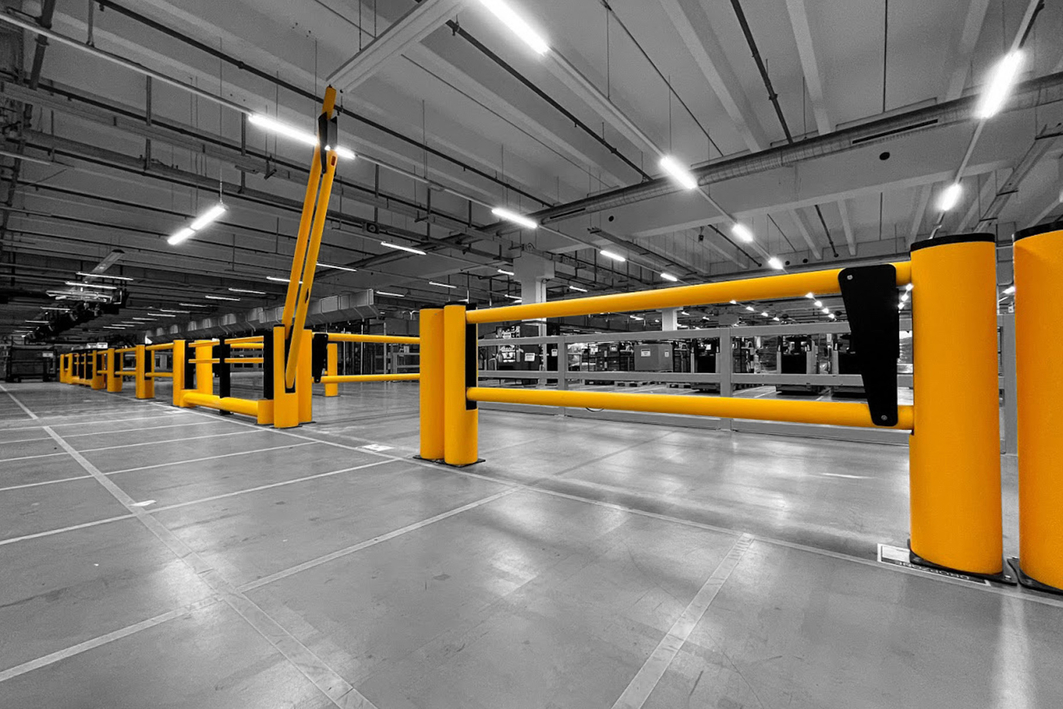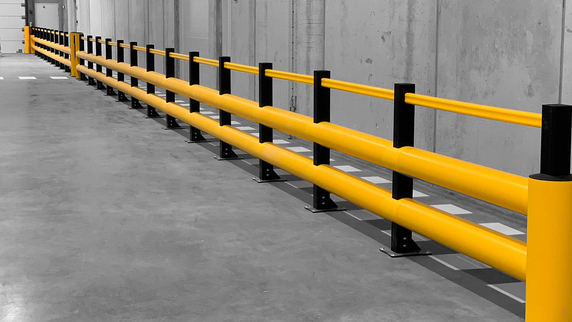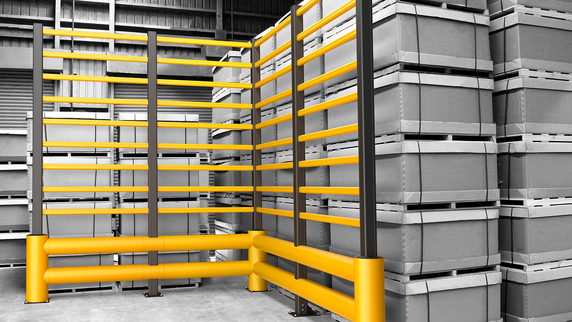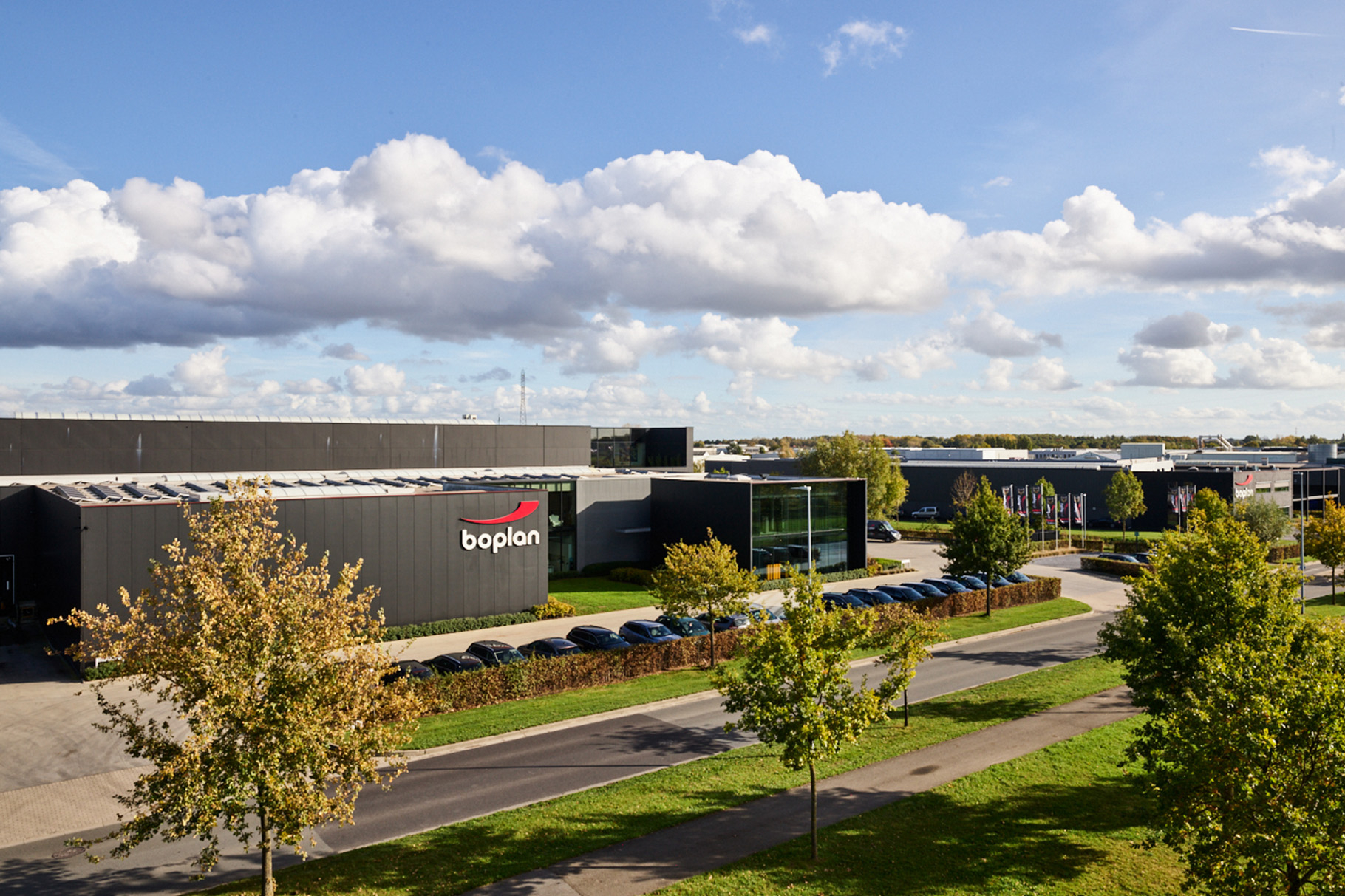Workplace safety
What contributes to a pleasant and enjoyable work environment? A positive attitude? Staff morale? Or perhaps the feeling of working in a safe environment?
In this overview blog, we highlight workplace risks and provide a summary of possible measures and solutions to improve workplace safety.
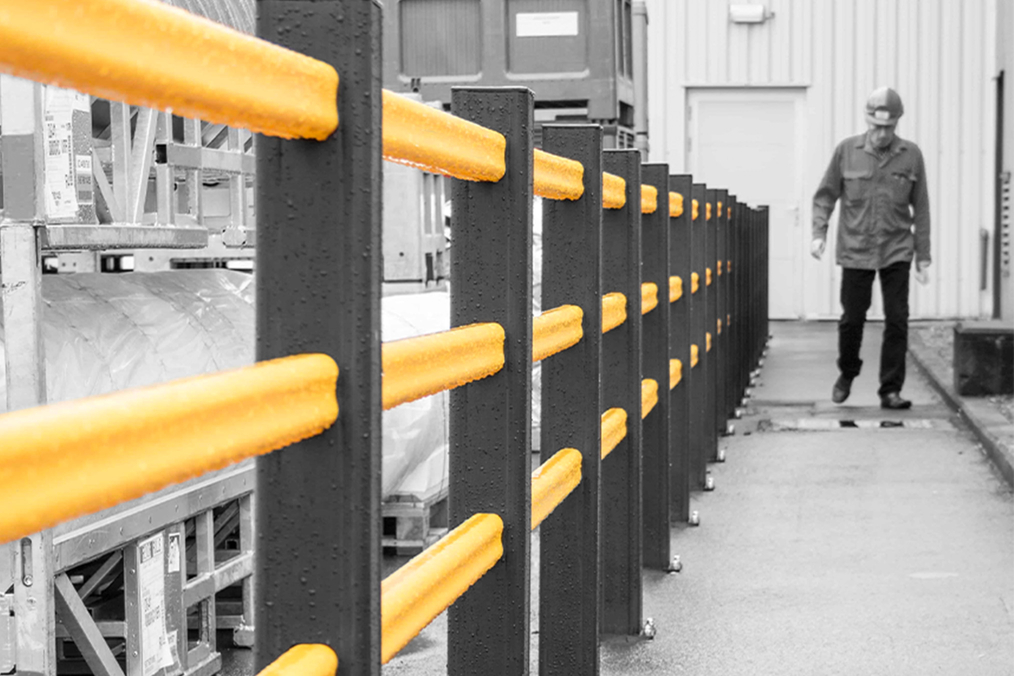
A healthy company begins with optimal workplace safety
It's just common sense. The consequences of a workplace accident are long-lasting. Not just economically, but psychologically as well. A company's profitability is directly tied to its investment in safety.
Workplace accidents often include forklift accidents, slips on wet floors, and falls from heights. Typically, people focus on prevention, training, and signage to reduce exposure to these safety hazards. This is a good initial step. However, accidents still happen. Rules raise safety awareness, but over time this awareness fades. Additionally, rules are not always followed in certain situations. Enforcing safety rules doesn't guarantee safety, but safety barriers do.
What is workplace safety?
Workplace safety encompasses all safety measures, rules, and regulations set by the government. We would like to emphasize the importance of employee participation at this point. The purpose of safety measures is to create a safer workplace. Their aim is to prevent accidents and provide protection against them. They are about both prevention and protection. They must provide a safe working environment for people, vehicles, infrastructure, machinery, and buildings.
Who is in charge of workplace safety?
It is the employer's responsibility to protect everyone and everything in the company properly. The Labor Act provides strict regulations organizations must follow in their operations. To ensure health and safety at work, employers must prioritize safety measures: from information and training to the installation of physical safety barriers. When they sign an employment contract with an employee, they guarantee to protect them.
Employers who do not meet safety regulations can be held liable with disciplinary, civil, or criminal penalties.
While employers are responsible for providing protection and clear safety policies, employees must follow them closely. Ultimately, everyone is responsible for adhering to workplace safety procedures and policies. By following the rules, everyone helps reduce the risk of accidents.
What hazards exist in the workplace?
In every warehouse, manufacturing environment, and industry, there are hazards that lead to accidents. We spend an average of 8 hours at work. For that reason alone, the risk of workplace accidents is higher than in other places. Hazard is always lurking around the corner. It is impossible to completely prevent accidents, but it is possible to make the workplace as safe as possible.
Identifying workplace risks is not easy, but it is worthwhile. Risks depend on the type of industry, the type of work, and environmental factors. A good way to identify and analyze risks is the PEEPO method. Let's examine this in more detail.
What are the outcomes of accidents at work?
The PEEPO method sets you on the path to enhanced workplace safety. That is important because the consequences are significant! We primarily consider the consequences for workers in the event of a workplace accident. Personal injuries are terrible and cause a lot of inconvenience, not just in the short term. The psychological impact also takes its toll.
Besides personal injuries, accidents can have a significant financial impact and lead to decreased productivity. Think about replacing or repairing critical machinery. Damaged utilities, buildings, and infrastructure are also costly. Not to mention the cost of downtime due to damaged vehicles, buildings, or infrastructure.
There is also the possibility that, as an employer, you may have to compensate victims if your safety provisions are found lacking. Your insurance premiums may also increase.
Recognizing the risks and consequences of workplace hazards is one thing, but the most important step is to determine how to prevent them. Because prevention is better than cure.
What safety measures can you take to reduce workplace accidents?
There are many steps you can take to enhance workplace safety. Below, we present a roadmap that goes from preventive measures to safety barriers, the only safety measure that provides effective impact protection.
- Conduct a risk assessment
We spend a significant part of our lives at work. Therefore, it is important that the working environment is safe for employees. A company must communicate any risks to its employees and use sufficient resources to ensure all employees can do their jobs safely. Every worker has the right to protection. This varies depending on the situation and needs. A risk assessment allows you to identify the initial safety focus areas and take the appropriate preventive measures. By evaluating the work environment and observing how people work and interact with equipment and each other, you can determine where accidents are likely to occur, where people or assets are at risk, and where safety measures are lacking. Here are some investigative methods for conducting a risk assessment.
- Create a traffic plan
Alongside a risk assessment, you need a traffic plan. This plan identifies the various traffic flows and bottlenecks within your organization. It offers insight into hazardous situations, such as areas where forklift traffic intersects with pedestrian pathways. The traffic plan and risk assessment lead to recommendations for physical protection, using safety barriers to limit damage in the event of an accident.
- Employee training
It's essential to provide effective training to machine operators and involve other employees in preparing safety measures. Prevention and training ensure that everyone understands and adheres to the measures. Training sessions like safety presentations help clarify the organization's safety measures. Employees who have been with your organization for years, new hires, and student workers all have a vested interest in learning about the company's safety aspects. After all, safety is an issue that affects everyone in the organization. The success of the implemented measures depends on everyone taking their share of responsibility.
- Use pictograms and floor marking tape
Besides employee training and guidance, the signs implementing safety principles in the workplace also play a crucial role. Prevention through signs reduces risk and makes it safer to navigate hazardous areas. For instance, you can make a hazardous area safer with pictograms and floor marking tape. In addition to identifying hazardous areas, road markings help define lanes, pedestrian zones, and vehicle zones. In short, they are an effective prevention tool.
- Provide personal protective equipment
People working at heights, handling heavy and bulky objects, or using material handling equipment are exposed to significant risks. Therefore, it's essential to provide people with personal protective equipment that protects them in hazardous conditions.
When working at heights, workers need a hard hat, sturdy harness, gloves, safety shoes... In the chemical industry, safety goggles ensure protection against hazardous products. This personal protective equipment is necessary but does nothing to protect the building, infrastructure, vehicles, or machinery. That's where your collective protective equipment comes in.
- Install collective protective equipment
Awareness, prevention, and personal protective equipment are essential, but you still depend on the goodwill and awareness of all employees to follow the rules. Even if your employees are exemplary in terms of safety, there will always be situations causing them to deviate from the prescribed path.
To prevent serious workplace accidents, you must ensure overall safety with polymer safety barriers and other physical safety solutions. Physical safety barriers serve two purposes. They prevent accidents and provide physical protection. Workers are more likely to notice the safety barriers and are encouraged to be more cautious. If an accident does occur, the safety barrier provides optimal protection to pedestrians, infrastructure, buildings, and vehicles.
What polymer safety solutions can you install in the workplace?
Polymer safety solutions are available for a wide range of applications, sizes, and situations. Here's a summary:
Safety and crash barriers are particularly useful for segregating different areas, preventing collisions between pedestrians and vehicles, maintaining a certain safe distance, or preventing falls from heights. Additionally, fall protection or fall arrest devices can also be part of your company's safety solutions. They are very useful for guiding people and preventing individuals or objects from falling from heights.
Click here to learn more about preventing falling objects.
Strategically placed bollards also significantly improve workplace safety. You can use polymer bollards to shield areas from vehicles, protect corners at entrances, and block traffic flow without vehicles sustaining any damage in the event of a collision. This is also an advantage of polymer bollards over their steel counterparts. In the event of a collision, there is little or no permanent damage to the bollard itself, other infrastructure, or the vehicle. Placing them at vulnerable key points in your work environment can save you a lot of money.
There are also various types of safety gates. Sliding safety gates are a space-saving solution for providing access to an area. There are also gates with self-closing doors that swing open or lift vertically. After a person has passed through, the safety gate closes automatically, allowing all pedestrians to move safely within the work area. Tip: combine safety gates with handrails at loading docks or other entrances and exits, for instance.
Use racking protection and column and corner protection to prevent vehicles from damaging the building or goods. This type of protection compels forklift drivers to pay more attention to vulnerable infrastructure. If they do hit it, the impact protection will ensure the racking and forklift are not damaged.
WHAT IS THE PEEPO METHOD?
The PEEPO method helps you identify the factors that are affecting workplace safety. PEEPO stands for People, Equipment, Environment, Product, and Organization. We discuss each aspect individually below.
People
Similar to road traffic, pedestrians are the most vulnerable in the workplace. Being distracted or acting improperly can have dramatic consequences. People may fall from heights, slip, ... and sustain serious physical and mental injuries.
To prevent workplace accidents, you need to consider the physical and cognitive ability of the workforce to perform the job. If an employee is not physically fit to perform the job, it will affect their performance and lead to accidents. Of course, the worker must also be mentally able to perform the job. Knowledge is crucial in this regard. Sharing knowledge about safety measures and standards within the company is essential. You can do this with a safety presentation, for instance. Training is also crucial to enable staff to perform certain actions. Consider the mandatory training for forklift drivers. Also, don't overlook the psychological component. It's unwise to place someone with little responsibility in a position where applying exceptional safety measures is crucial.
Equipment
Equipment also impacts workplace safety. Consider machinery and tools. Each machine comes with safety instructions. Ensure people follow them and that the machine is in good condition. Sometimes machines or parts of machines are unshielded. In such cases, provide shielding or protection. Shielding prevents people from accidentally coming into contact with the machine. Protection like polymer safety barriers stops vehicles from hitting machines.
Environment
The environment plays a significant role in workplace safety. As an employer or safety expert, you can only partially influence an employee's behavior, but you have complete control over the safety measures in your work environment. This is where you differentiate between a healthy, safe workplace and a potential 'disaster area'.
Traffic, light, and temperature are three environmental factors that impact workplace safety:
- Traffic
In large production areas and distribution centers, forklifts and pallet trucks are the stars of the show. They skillfully navigate narrow aisles and winding pathways through a warehouse full of racking. It's evident that this involves certain risks: They could crash into the building, other vehicles, or worse, pedestrians! Drivers might consider bending the rules to meet their targets. They might load more weight than allowed, or they might drive too fast. The result: they hit the racking, damage a wall or load, or even collide with a colleague.
Learn about:
- Lighting
Many factory buildings have few windows and limited natural light. Artificial lighting is the main light source there. Of course, this isn't a problem as long as there's sufficient lighting everywhere. Inadequately lit areas or goods lead to accidents. Other causes include thresholds, depths, racking, and objects situated above the traffic with low headroom and protruding structures. Lack of lighting may also cause items to go unnoticed. This, in turn, leads to falls. So, ensure you work in an orderly manner. Learn how to better organize your workspace here.
- Temperature
Some companies operate in freezing temperatures (frozen foods). Others operate in extreme heat (steel manufacturers). In both cases, workers need adequate protection with clothing and equipment. Did you know we've developed safety equipment specifically for extremely cold work environments? Download the Safety in Freezing Environments white paper to learn about suitable safety solutions for freezers.
Product
The type of product also plays a crucial role in determining a company's risk. For instance, companies working with chemical, flammable, or nuclear materials require special safety measures. An accident involving a toxic load can have serious consequences. In a worst-case scenario, this results in injuries or deaths with all the legal and financial consequences they entail. Ensure such areas are well protected against collisions.
Organization
The organization aspect is closely related to the environment theme. It mainly involves the layout of the workplace. By making the workplace safe and efficient, you minimize the risk of accidents. Maintain an overview of the workplace and provide a clear organization method. Goods that are not in their proper place pose a risk to people. Prevent slips and falls by keeping the workplace clean and tidy. These are usually small steps to implement but are crucial for improving workplace safety.
We keep you updated!
Investing in the above safety products ensures your company meets safety regulations and is ready for any safety inspections. Protect people, infrastructure, machinery, and buildings! It's the only way to have a safe workplace and peace of mind.
Feel free to get more information from our blogs and industry-specific white papers, or contact us. We look forward to taking your workplace safety to the next level with you.
